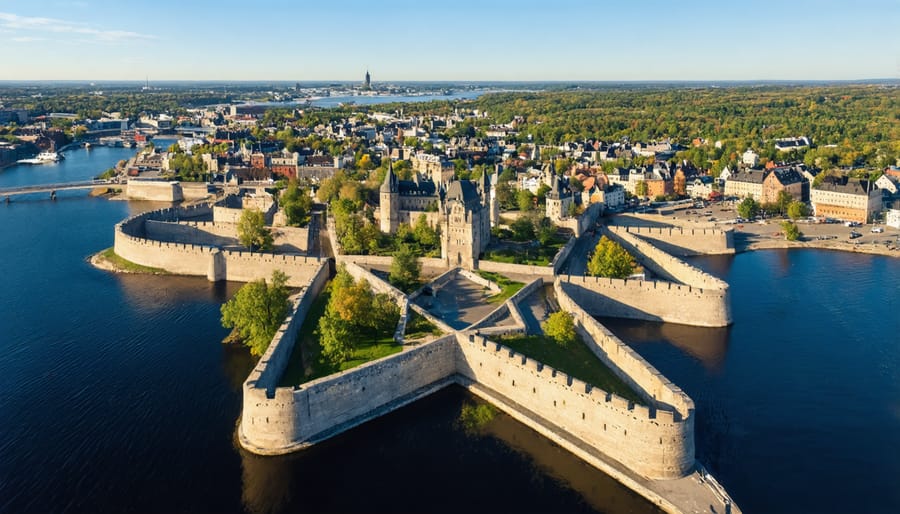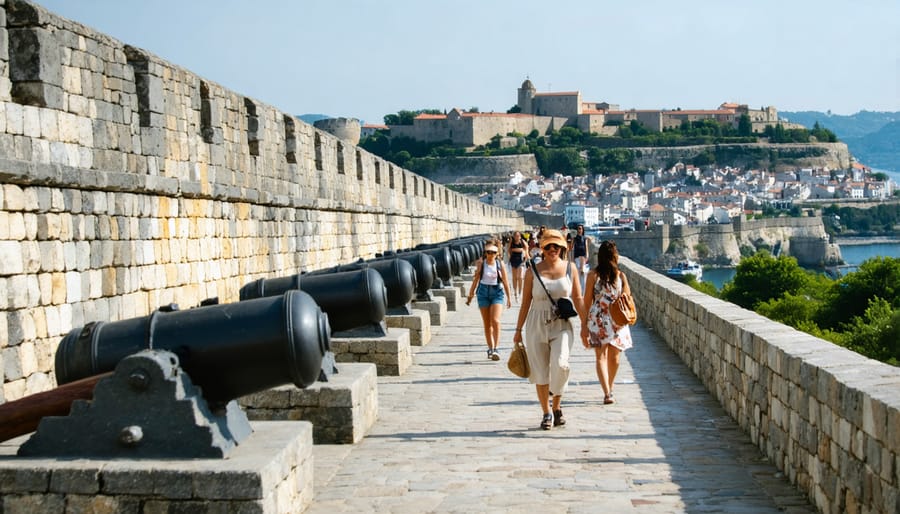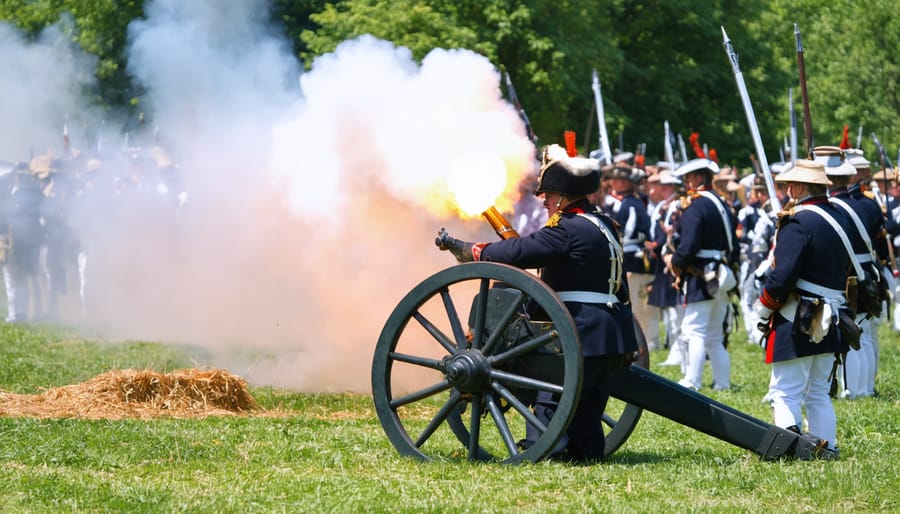Standing as North America’s only remaining fortified colonial city, Quebec City’s historic walls tell a story of strategic brilliance and cultural preservation that shaped Canada’s early history. The imposing 4.6-kilometer stone fortifications, built between 1608 and 1871, wrap around the heart of Old Quebec like a protective embrace, offering Ontario visitors a chance to step back in time and experience authentic colonial military architecture.
From the commanding heights of the Citadelle to the charming stone gates that pierce the walls, these UNESCO World Heritage fortifications showcase an ingenious defense system that protected New France from British invasion attempts. Today, visitors can walk atop the preserved ramparts, explore underground tunnels, and join guided tours that bring to life the dramatic sieges and battles that unfolded here.
Whether you’re strolling along the Governor’s Promenade or watching the changing of the guard at the Citadelle, these remarkably intact fortifications offer Ontario travelers an unforgettable glimpse into the shared colonial history that shaped both provinces.
The Strategic Marvel of Quebec’s Fortifications

A Military Engineering Masterpiece
When you walk along Quebec City’s walls today, you’re experiencing one of North America’s finest examples of military engineering. Built between 1608 and 1871, these fortifications showcase ingenious defensive features that made the city nearly impregnable. The star-shaped design, typical of European military architecture, allowed defenders to cover all angles of approach with overlapping fields of fire.
The walls, stretching for 4.6 kilometers, were constructed using locally quarried limestone and incorporate clever design elements like deep ditches, artillery platforms, and underground passages. What makes these fortifications particularly remarkable is how they adapt to Quebec City’s unique terrain. The engineers brilliantly used the natural cliff faces of Cape Diamond, integrating them into the defensive system.
The most impressive feature is the Citadelle, built in the shape of a perfect star. Its walls are up to 25 feet thick in some places and include 24 buildings designed to house everything needed for a long siege. Today, you can still see the original cannons, powder magazines, and soldiers’ barracks, offering a fascinating glimpse into military architecture of the colonial era.
The French-British Connection
The fortifications of Quebec City played a pivotal role in shaping the expansion of British and French territories into what would later become Ontario. As the primary defensive stronghold in New France, Quebec’s impressive walls and strategic location along the St. Lawrence River created a secure base for French exploration westward. This influence can still be seen today in many colonial forts in Ontario, which were built following similar architectural principles.
When the British conquered Quebec City in 1759, they inherited not just the fortifications but also the established trade routes and relationships with Indigenous peoples. This transfer of power fundamentally shaped how Ontario would develop. The British used Quebec’s fortifications as a model for their own defensive structures along the Great Lakes, establishing a network of protected settlements that encouraged colonial expansion.
Fun fact: Many of the engineering techniques used in Quebec’s walls were later adapted for forts in Kingston and Niagara, creating a fascinating architectural connection between these historic sites that visitors can still explore today.
Exploring the Walls Today
Walking Tours and Viewpoints
The best way to experience Quebec City’s historic fortifications is through a leisurely walk along the 4.6-kilometer fortification wall, which takes about 2-3 hours to complete. Start your journey at Saint-Louis Gate, where friendly Parks Canada guides offer fascinating insights into the city’s military history.
For breathtaking views of the St. Lawrence River, head to the Dufferin Terrace near Château Frontenac. This elevated boardwalk offers perfect photo opportunities, especially during sunrise when the morning light bathes the fortifications in a golden glow. Don’t miss the Artillery Park, where you can climb to the top of the walls for a bird’s-eye view of the Lower Town.
The Citadel, Quebec’s largest fortress, offers guided tours that bring the city’s military heritage to life. Pro tip: time your visit for the changing of the guard ceremony during summer months. For a less crowded experience, explore the Joan of Arc Garden and the Plains of Abraham, where interpretive panels tell the story of the famous 1759 battle.
Consider joining a guided evening tour when the fortifications are beautifully lit, creating a magical atmosphere. For the best experience, wear comfortable walking shoes and bring a water bottle – many of the original stone paths are uneven, but that’s part of their historic charm!

Seasonal Events and Reenactments
Throughout the year, Quebec City’s fortifications come alive with vibrant historical reenactments and seasonal events that showcase the city’s rich War of 1812 military heritage and colonial past. During summer weekends, costumed interpreters in period military uniforms conduct musket-firing demonstrations and march along the fortress walls, offering visitors an immersive glimpse into 18th and 19th-century military life.
The highlight of the seasonal calendar is the annual Great Celebration of New France in August, when the fortifications serve as a dramatic backdrop for hundreds of period-dressed performers recreating daily life from the French colonial era. Visitors can watch military drills, learn traditional crafts, and even participate in mock battles.
During winter, the fortifications host special nighttime guided tours where lantern-carrying guides share spooky tales of sieges and soldiers’ lives. The annual Quebec Winter Carnival also incorporates the historic walls into its festivities, with ice sculptures and light displays illuminating the centuries-old stonework.
Pro tip: Book your visit to coincide with Victoria Day weekend in May when special demonstrations honor the historic connections between Quebec and Ontario, featuring displays of traditional military ceremonies from both provinces. Remember to arrive early for the popular cannon-firing demonstrations, and don’t forget your camera – the authentically dressed performers are always happy to pose for photos!

Planning Your Visit from Ontario
Best Times to Visit
Quebec City’s fortifications are magnificent year-round, but each season offers unique experiences. Summer (June to August) brings perfect weather for walking tours and photography, with temperatures between 20-25°C and extended daylight hours. This is peak tourist season, so book accommodations well in advance.
Fall (September to October) is arguably the most picturesque time to visit. The crisp autumn air and colorful foliage create stunning backdrops for the stone walls, and crowds thin out considerably. Plus, you’ll enjoy comfortable temperatures around 15°C – ideal for exploring the 4.6-kilometer fortification circuit.
Winter transforms the fortifications into a magical scene, especially during February’s Winter Carnival. The snow-covered ramparts offer unique photo opportunities, though dress warmly as temperatures can dip below -15°C. Many visitors combine their fortification tours with skating at the Plains of Abraham.
Spring (April to May) brings renewal to the city, with flowering trees and gardens coming to life along the walls. While you might encounter some rain, prices are lower and crowds are minimal. For history enthusiasts, the Victoria Day weekend in May features special military demonstrations at the Citadel, adding an extra layer of historical immersion to your visit.
Travel Tips and Accommodations
Planning a trip to Quebec City’s fortifications from Ontario is easier than you might think. The most convenient option is flying directly from Toronto or Ottawa to Jean Lesage International Airport, with flights typically taking around 90 minutes. Alternatively, follow the historic travel routes by car along Highway 401 and 20, making it a scenic 8-hour drive from Toronto.
For the best experience, stay within Old Quebec’s walls – you’ll be steps away from the fortifications and immersed in the historic atmosphere. The iconic Fairmont Le Château Frontenac offers luxury accommodations with stunning views, while charming boutique hotels like Hotel du Vieux-Quebec provide more budget-friendly options with local character.
Visit between May and October for comfortable weather and walking conditions. Summer months offer special guided tours and historical reenactments, but spring and fall generally mean fewer crowds and better rates. Purchase a Parks Canada Discovery Pass before your trip for unlimited access to the fortifications and other national historic sites.
Pro tip: Book accommodations at least three months in advance for peak summer season, and consider visiting midweek for better availability and prices.
While Quebec City’s fortifications stand as a remarkable testament to French colonial defense, they share fascinating connections with Ontario’s own colonial heritage. As you explore these magnificent walls, remember that many of the military engineers who worked on Quebec’s defenses also contributed to fortifications across Ontario, including Fort Henry in Kingston and Fort York in Toronto. These shared architectural and defensive strategies highlight the intertwined nature of Canada’s colonial past.
For Ontario visitors, Quebec’s fortifications offer valuable insights into our collective heritage and the broader story of European settlement in North America. The preservation techniques and restoration methods pioneered in Quebec City have influenced heritage conservation practices across Ontario, helping us protect our own historic sites for future generations.
Whether you’re an Ontario resident or visiting from abroad, experiencing Quebec’s fortifications can deepen your appreciation for Canada’s rich military architecture and inspire you to explore similar historic sites closer to home. Consider making Quebec City’s fortifications part of a larger heritage journey through eastern Canada, connecting the dots between our shared colonial past.














+ There are no comments
Add yours